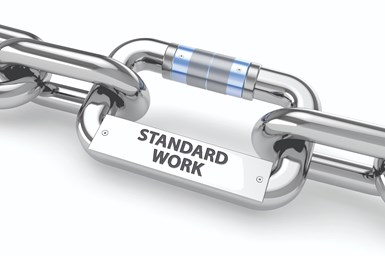Why You Should Consider Standard Work
Standard work is a means to reduce the number of decisions that your performers need to make in order to ensure that compliant parts are produced.

Standard work is a process of helping our performers discover and then sustain the very best practices for doing the tasks needed to deliver compliant parts on time.
Standard work is a technique that is used across the economy to reduce variation in otherwise uncontrolled processes. I like the definition of standard work given by KaiNexus, “Standard work is the practice of setting, communicating, following, and improving standards. Establishing standard work begins with creating, clarifying, and sharing information about the most efficient method to perform a task that is currently known with everyone performing that process. Once this information has been shared, everyone practices this standard consistently so that the work is done the best way every time. This is where continuous improvement comes into play; standard work isn’t a “set it and forget it” process, announced once and then permanently unchanging. Instead, everyone should work to improve the standard, and share new best practices as they’re discovered.”
- Do you produce the same products across different shifts?
- Do you have different set-up people setting up your processes?
- Do you have different people grinding tools?
- Do you have different suppliers providing tools, materials, supplies?
- How much of this variability does your customer’s process have to deal with?
Different Shifts, Different Results
As a young metallurgist, I was called into plants running automotive parts on multi-spindle screw machines and the plants were convinced that the problem was my steel. After collecting the facts across shifts and operators, we learned that 1) the steel runs fine on all machines on day shift; 2) it has problems drilling on one particular machine on second shift; and 3) it won’t hold size or finish on the third shift. The steel was from the same truckload delivery, same mill production run, same heat and same hot mill supplier to me as a cold finisher.
If the steel ran fine on all machines on day shift, what does that say about the steel? It says that the problems encountered on the other shifts are caused by differences in operating practices, not the actual steel. Setting standards for how to operate across shifts is key if we are to ensure that variability of the drilled features is to be controlled and that the OD features and finish are held to the same capability regardless of shift, machine and operator.
A Means to a Compliant End
How can you ensure consistency across shifts, machines and operators if you do not have a process to standardize your operational practices? Standard work is not a means to eliminate an employee’s responsibility to make compliant parts. Standard work is a means of reducing the number of decisions that they need to make in order to ensure that compliant parts are produced. It eliminates confusion: “Should I use this tool or that one?” or “Should I use this holder or that?” It reduces doubt and gives the operator confidence that they are using the most effective method to produce the features and parts.
The goal of standard work is to reduce the employees’ need to make choices or decisions, by outlining a consistent best practice to achieve the manufacturing outcome. It empowers them to confidently perform, rather than worry about whether what they are trying to do will work.
Standard work is not just for the shop. United Parcel Service (UPS) created a form of standard work for their delivery drivers — no left turns. Data showed that left turns created delays waiting for traffic to clear, were responsible for accidents, contributed to increased fuel consumption (while waiting to cross traffic), and slowed down deliveries. By standardizing routes to minimize left turns, UPS reduced traffic delays, increased the number of packages delivered per unit of time, reduced accidents which improved safety and reduced fuel consumption.
Do you have a standard process for receiving sales inquiries? For doing the engineering review for new inquiries? Do you have a standard set of screening questions so that your engineering talent are working only on the right items to quote that fit your capability? Or are they doing each item as they come in, piecework, one at a time? Do you have a priority for quoting based on your preferred kind of business, machines being utilized, volume or material?
Standard work is not about management telling employees what to do and how to do it. Standard work is a process of helping our performers discover and then sustain the very best practices for doing the tasks needed to deliver compliant parts on time. Many shops that I have visited have islands of standard work. Like the shop at the beginning of this article, day shift had their processes and practices standardized and “down cold.” But the standard practices were not standard on the back shifts. Standard work requires the investment of team time to discover, agree upon and execute the very best practices. How do you help your performers do that?
Helping your performers to identify their very best practices — their ways and means — may be the first giant leap that your organization takes toward continuous improvement. Because only once there is a stable and sustained process, will incremental improvements that permanently improve outcomes be possible, rather than to just inflict unwanted variability and change on our customers.
Read More Articles from PMPA:
- Subscribe to PMPA Podcasts
- Beware of False Unemployment Claims Filed with Your Information
- Honing and Lapping — Special Finish Processes
About the Author
Miles Free III is the PMPA Director of Industry Affairs with over 40 years of experience in the areas of manufacturing, quality, and steelmaking. He helps answer “How?, “With what?” and “Really?” Miles’ blog is at pmpaspeakingofprecision.com; email – mfree@pmpa.org; website – pmpa.org
Related Content
A No/Low-Cost Solution to Employee Retention
Studies show a little employee recognition goes a long way. Here are the 5Ws to consider for success.
Read MoreCraftsman Cribsheet No. 119: Defeating the Hanging Cross-Hole Burr
Deburring is a tedious task that is better left to machines.
Read MoreOnshoring Weather Report: Strong Tailwinds!
Onshoring, reshoring, nearshoring: these terms are showing up with increasing frequency in the news and online. But is there evidence that these are real?
Read MoreCraftsman Cribsheet No. 126: AISI System of Identification
Source: PMPA Prior to the Society of Automotive Engineers taking responsibility for Steel Grade nomenclature in the United States (1995), the American Iron and Steel Institute determined U.S. standard steel grades in collaboration with SAE.
Read MoreRead Next
A Tooling Workshop Worth a Visit
Marubeni Citizen-Cincom’s tooling and accessory workshop offers a chance to learn more about ancillary devices that can boost machining efficiency and capability.
Read MoreDo You Have Single Points of Failure?
Plans need to be in place before a catastrophic event occurs.
Read More5 Aspects of PMTS I Appreciate
The three-day edition of the 2025 Precision Machining Technology Show kicks off at the start of April. I’ll be there, and here are some reasons why.
Read More







.jpg;maxWidth=300;quality=90)















